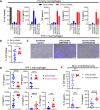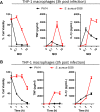Impairment in inflammasome signaling by the chronic Pseudomonas aeruginosa isolates from cystic fibrosis patients results in an increase in inflammatory response
- PMID: 33664232
- PMCID: PMC7933143
- DOI: 10.1038/s41419-021-03526-w
Impairment in inflammasome signaling by the chronic Pseudomonas aeruginosa isolates from cystic fibrosis patients results in an increase in inflammatory response
Abstract
Pseudomonas aeruginosa is a common respiratory pathogen in cystic fibrosis (CF) patients which undergoes adaptations during chronic infection towards reduced virulence, which can facilitate bacterial evasion of killing by host cells. However, inflammatory cytokines are often found to be elevated in CF patients, and it is unknown how chronic P. aeruginosa infection can be paradoxically associated with both diminished virulence in vitro and increased inflammation and disease progression. Thus, we investigated the relationship between the stimulation of inflammatory cell death pathways by CF P. aeruginosa respiratory isolates and the expression of key inflammatory cytokines. We show that early respiratory isolates of P. aeruginosa from CF patients potently induce inflammasome signaling, cell death, and expression of IL-1β by macrophages, yet little expression of other inflammatory cytokines (TNF, IL-6 and IL-8). In contrast, chronic P. aeruginosa isolates induce relatively poor macrophage inflammasome signaling, cell death, and IL-1β expression but paradoxically excessive production of TNF, IL-6 and IL-8 compared to early P. aeruginosa isolates. Using various mutants of P. aeruginosa, we show that the premature cell death of macrophages caused by virulent bacteria compromises their ability to express cytokines. Contrary to the belief that chronic P. aeruginosa isolates are less pathogenic, we reveal that infections with chronic P. aeruginosa isolates result in increased cytokine induction due to their failure to induce immune cell death, which results in a relatively intense inflammation compared with early isolates.
Conflict of interest statement
The authors declare no competing interests.
Figures








Similar articles
-
Clinical Isolates of Pseudomonas aeruginosa from Chronically Infected Cystic Fibrosis Patients Fail To Activate the Inflammasome during Both Stable Infection and Pulmonary Exacerbation.J Immunol. 2016 Apr 1;196(7):3097-108. doi: 10.4049/jimmunol.1501642. Epub 2016 Feb 19. J Immunol. 2016. PMID: 26895832
-
Pseudomonas aeruginosa Lipid A Structural Variants Induce Altered Immune Responses.Am J Respir Cell Mol Biol. 2024 Aug;71(2):207-218. doi: 10.1165/rcmb.2024-0059OC. Am J Respir Cell Mol Biol. 2024. PMID: 38656811 Free PMC article.
-
Inflammasome Genetic Variants, Macrophage Function, and Clinical Outcomes in Cystic Fibrosis.Am J Respir Cell Mol Biol. 2021 Aug;65(2):157-166. doi: 10.1165/rcmb.2020-0257OC. Am J Respir Cell Mol Biol. 2021. PMID: 33848452 Free PMC article. Clinical Trial.
-
Harnessing Neutrophil Survival Mechanisms during Chronic Infection by Pseudomonas aeruginosa: Novel Therapeutic Targets to Dampen Inflammation in Cystic Fibrosis.Front Cell Infect Microbiol. 2017 Jun 30;7:243. doi: 10.3389/fcimb.2017.00243. eCollection 2017. Front Cell Infect Microbiol. 2017. PMID: 28713772 Free PMC article. Review.
-
Microevolution of Pseudomonas aeruginosa to a chronic pathogen of the cystic fibrosis lung.Curr Top Microbiol Immunol. 2013;358:91-118. doi: 10.1007/82_2011_199. Curr Top Microbiol Immunol. 2013. PMID: 22311171 Review.
Cited by
-
Deacetylation of Histones and Non-histone Proteins in Inflammatory Diseases and Cancer Therapeutic Potential of Histone Deacetylase Inhibitors.Curr Genomics. 2023 Nov 22;24(3):136-145. doi: 10.2174/0113892029265046231011100327. Curr Genomics. 2023. PMID: 38178983 Free PMC article. Review.
-
AtbFinder Diagnostic Test System Improves Optimal Selection of Antibiotic Therapy in Persons with Cystic Fibrosis.J Clin Microbiol. 2023 Jan 26;61(1):e0155822. doi: 10.1128/jcm.01558-22. Epub 2023 Jan 5. J Clin Microbiol. 2023. PMID: 36602344 Free PMC article.
-
Antioxidant and Anti-Inflammatory Effects of Thyme (Thymus vulgaris L.) Essential Oils Prepared at Different Plant Phenophases on Pseudomonas aeruginosa LPS-Activated THP-1 Macrophages.Antioxidants (Basel). 2022 Jul 6;11(7):1330. doi: 10.3390/antiox11071330. Antioxidants (Basel). 2022. PMID: 35883820 Free PMC article.
-
Early host immune responses in a human organoid-derived gallbladder monolayer to Salmonella Typhi strains from patients with acute and chronic infections: a comparative analysis.Front Immunol. 2024 Mar 12;15:1334762. doi: 10.3389/fimmu.2024.1334762. eCollection 2024. Front Immunol. 2024. PMID: 38533492 Free PMC article.
-
Neutrophil extracellular traps and interleukin-1β in cystic fibrosis lung disease.Front Immunol. 2025 Jul 28;16:1595994. doi: 10.3389/fimmu.2025.1595994. eCollection 2025. Front Immunol. 2025. PMID: 40791588 Free PMC article. Review.
References
Publication types
MeSH terms
Substances
Grants and funding
LinkOut - more resources
Full Text Sources
Other Literature Sources
Medical

